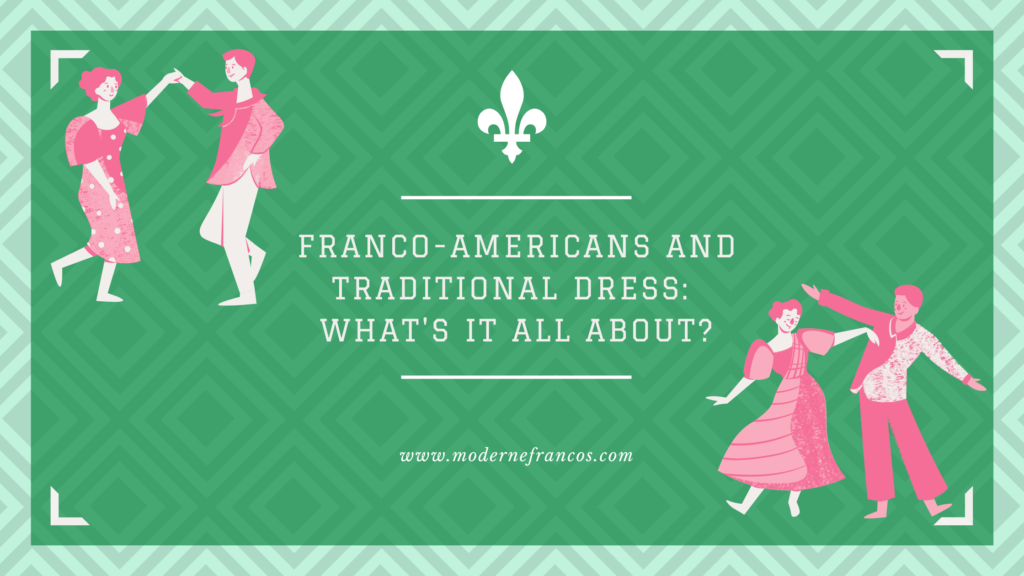
Cultures all over the world have a form of traditional dress or folk costume. Some of these cultures have retained this part of themselves, continuing to wear their garb daily. Others save this festive type of dress for special occasions, ceremonies, or cultural festivals.
Traditional dress and folk costume is pure artistic expression that connects people with the fabrics, patterns, and clothing created by the people of their culture or within their region of the world.
This clothing is a visual representation of the culture itself, as well as offering functionality depending on the main climate of the area. But the real treat is taking in the amazing colors, patterns, textures, and shapes.
The artistry and creativity of cultural clothing around the world blows me away. You don’t even have to go that far back in time to find these amazing creations because most traditional dress and folk costumes are based on historical dress primarily between the 1800s-1900s.
Defining Traditional Dress & Folk Costumes
Traditional dress, sometimes called a folk costume, expresses an identity of a cultural group that is usually an ensemble of clothing, jewelry, and other accessories rooted in the past that were worn by an identifiable culture of people. It’s also associated with a geographic area or a period of history. Although the ensemble can go through slight changes over time, it’s mostly unchanged from the original inspiration of clothing from the past.
You can see for yourself the beautiful designs and fashions from all over the world. Even better is an online trend that I’ve previously mentioned called the Culture Challenge. In this challenge typically found on Tik Tok, a person (or group) shows themselves as they dress daily. Then with a change of music, they reveal the traditional dress of their culture.
It’s inspiring to see the variety and diversity of the cultural clothing and accessories. The rich colors, stunning jewelry, and the look on their faces of this is my culture and I’m proud of it make me wish that our culture was more identifiable.
What Does This Mean For Franco-Americans?
How would we as Franco-Americans with a Québécois, French-Canadian, or Acadian background be able to participate in this Culture Challenge?
There’s been no real direction in how our culture would have expressed itself in the art form of fashion.
Perhaps our working class ancestors only created a few unique items because they had to adhere to strictly functional clothing. But I don’t think that should stop us from creating something identifiable for ourselves.
When talking about the traditional dress or folk costume of Québécois, French-Canadians, and Acadians, I have been met with resistance. Even more so when I want to talk about how that would translate into ideas for Franco-Americans.
There’s a major disconnect from expressing our culture through fashion, without realizing the importance of creating visuals. This is how you become a loud presence.
It’s no wonder that we can identify other cultures by the clothing they wear for a certain festival or ceremony, but no one can identify us as beyond our Americanized surface.
Although it’s easy to assume that our ancestors strictly wore what was functional to survive their new, harsh environment, artistry will always find a way. People have been making clothing with decorative elements for thousands and thousands of years, so don’t deny your 9th great-grandmother the title of Habitant Fashion Queen.
When the new inhabitants arrived in New France, they wore the fashion trends and styles of France that arrived at their new home by ship. But the French-Canadians no longer had the direct accessibility to new styles because the ships carrying clothing all the way from France took about a year to reach their shores.
Another major factor that affected the way French-Canadians dressed were the interactions between the habitants, fur traders, and the Indigenous people of Canada. The key items of early French-Canadian clothing are the ceinture fléchée, tuque, and the Capote.
Where to Start? Here Are the Main Clothing Items
Voyageurs fashioned the ceinture fléchée, also known as the arrowhead belt. Primarily worn by men at the time, these woven wool belts were made for the cold weather. The main function was to wrap around a coat to keep it closed and retain body heat.
There is debate about whether this was an invention of the French-Canadians, the Métis, or Indigenous tribes. But there’s no doubt that this belt was a common staple and even a status symbol among men of these different backgrounds at the time.
The ceinture fléchée were woven by French-Canadian women who formed their own distinct patterns for their region. So the creativity and labor should be credited to these women for creating the labor-intensive pieces with such beauty and intricacy.
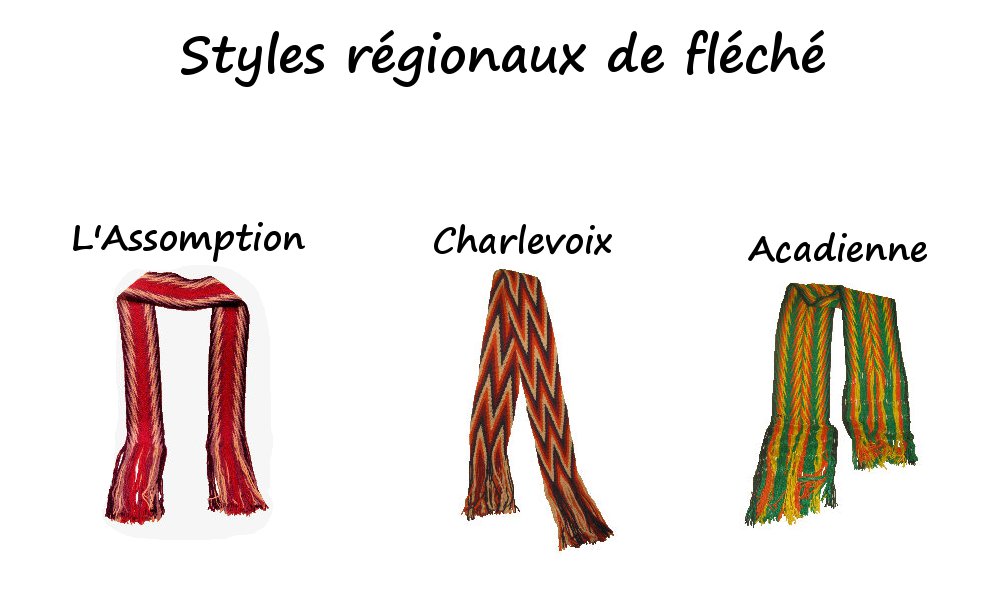
This is one main piece of traditional dress that we can start with in creating an identity through our cultural fashion. In fact, I’ve seen photos of men and women (even Bonhomme!) wearing the ceinture fléchée during the Carnaval de Québec, or the Québec Winter Carnival.
The tuque is the next piece of clothing (also worn by the fashionable Bonhomme). This is a knitted wool cap with a long tassel. These were also a main piece of clothing for Voyageurs, but women wore them as well. According to one source, tuques have been in Québécois fashion since the late 16th century.
The early versions of the tuques were brimless and made of black velvet. In the 19th century, women wore tuques that were smaller and decorated with fur, lace, bows, flowers, or even leaves.
Moving on to our next item, the Capote is a long coat that is worn with the ceinture fléchée tied around the waist. This “blanket coat” is knee-length with combined elements of military coats worn at that time.

From the Québec French term capot, the verb encapoter or s’encapoter described the action of putting the Capote and other winter gear on before heading out.
In the late 19th century, Canadians considered this coat as national dress. The Montréal Snow Shoe Club required the Capote as their official team outfit. The Métis also wore this coat with the ceinture fléchée, so these items have a fascinating shared history. But due to the larger fashion industry, this coat went out of style in favor of Westernized styles.
Clothing Styles Unique to Women
Basics for women in the 17th century were a linen chemise, one or two jupon, and stays that acted as the foundation for their gown or jacket. A fichu was worn around the shoulders and tucked in the front of a woman’s gown. A coiffe was worn on the head at all times unless a woman’s hair was styled.
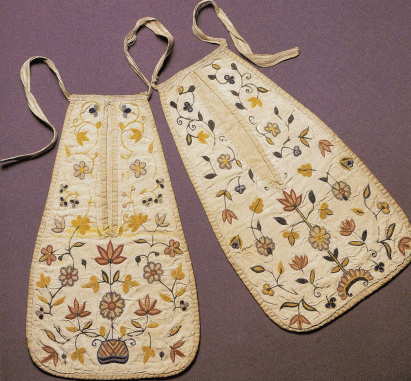
Another item were embroidered needlework pockets that could be worn over or underneath the jupon. Pockets were not sewn into dresses or skirts at that time, so they were a separate piece. To wear over the jupon, they were simply tied around the waist. The top layer of the jupon had slits, so the pockets could also be worn underneath and still be easily accessible.
French-Canadian women of that time also wore wide-brimmed hats over their coiffe to keep the sun out of their faces. Which is similar to the hats these dancers wear while performing traditional Québécois and French-Canadian music and dance.
Comparisons to Regional Outfits in France
I find this women’s style of the wide-brimmed hat similar to the traditional dress of Nice, France. The girls and women wear a version of the basic clothing and top it off with a striped skirt and wide-brimmed hat. As seen in this traditional dance with the addition of a Maypole.
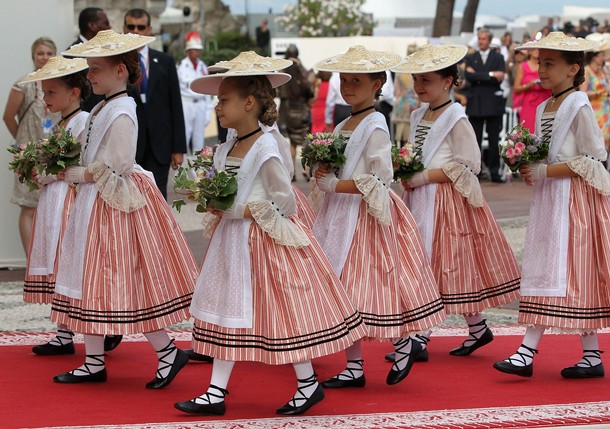
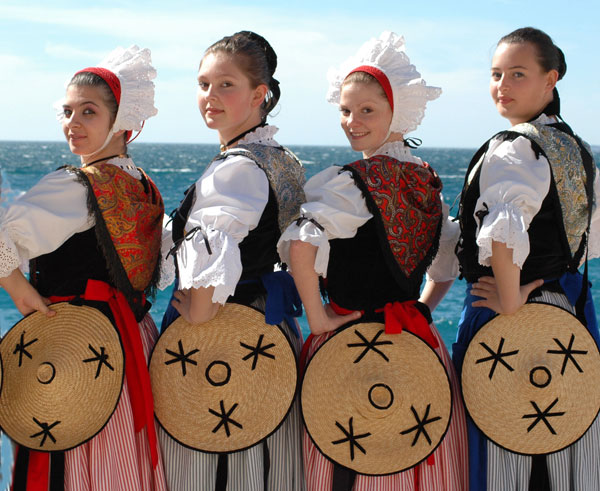
The wide-brimmed hat is also found in the Lyonnais region of France. The girls and women wear the hats on their backs or over their coiffe. This outfit looks most similar to the dress of the Québécois and French-Canadian women in their folk dance.
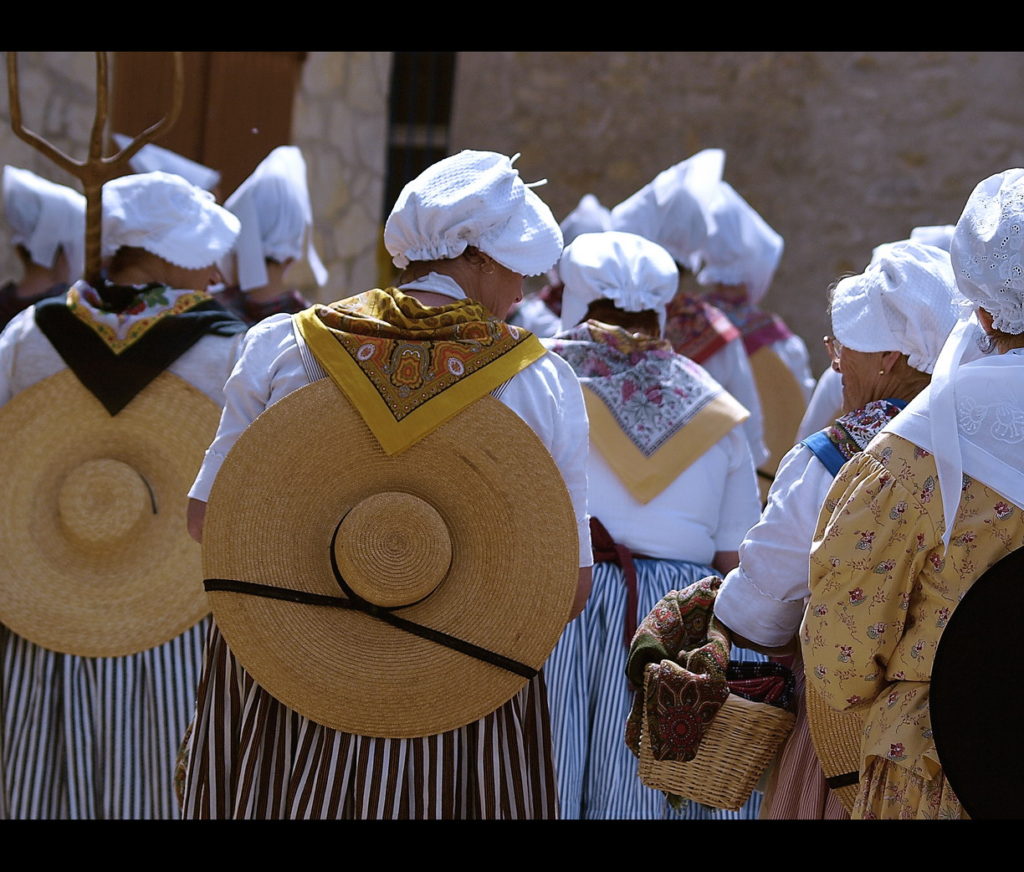
The decorative wide-brimmed hat could become a part of our identity in addition to the ceinture fléchée, tuque, and Capote. I particularly adore the cultural dress of the Brittany region in France. The women fashion a major piece of clothing that really makes a statement: their extravagant lace coiffe that comes in all sorts of different shapes and heights.
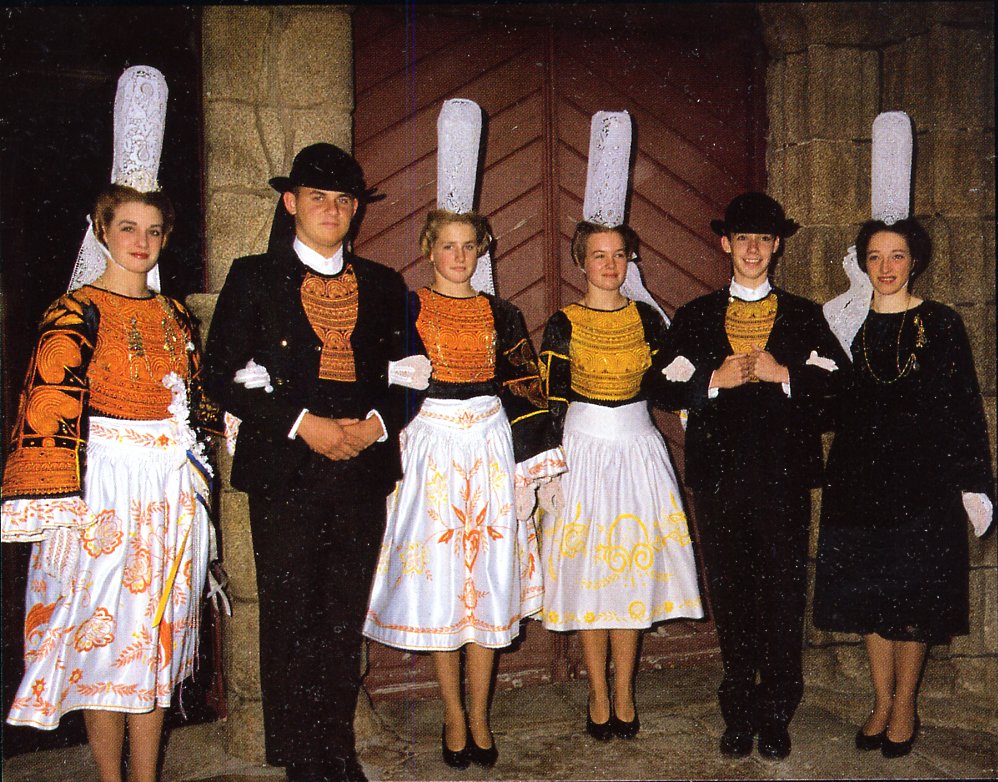
The region has a history of lacemaking, as well as other textile work like embroidery and woven arts. The “Breton costume” didn’t really gain notoriety until the early 1900s, when there were about 800 different varieties of these coiffe headdresses. And the costumes are never quite the same, as there are about 66 different styles of dress.
These folk costumes have changed over time, in fact, the coiffe has only gotten taller at 30-40 cm (11-15 inches). So there’s a creative aspect in taking inspiration from a clothing item of the past and using your artistic expression to create something out of it.
There is also a thriving community of Breton-Canadians who participate in the dress, dance, and music of their cultural background. The Breton culture-inspired restaurant, Au Petit Coin Breton, is located in Québec and celebrates the region’s traditional dress. The waitresses even wear the Breton dress with the coiffe.
Of course, there are many different styles of traditional dress and folk costume throughout the regions in France. Luckily, we have photographs and illustrations of how this dress looked back then. So we can really admire the hard work and dedication behind these designs of Northern and Southern France.
Acadian Traditional Dress in Folk Dancing and Celebrations
The Maritime provinces appear to have a traditional dress worn by Acadians in folk dance groups and other cultural events. The outfits in this dance competition in Nova Scotia are the basics of a white blouse, black vest, and a bold red skirt.
Variations on this folk dancing outfit include a blue skirt rather than red, or a skirt with blue and red on the front and back. A coiffe is sometimes worn with this traditional dress. There is also an outfit with a white blouse, blue vest with the yellow star of Acadia, and a red skirt. Attendees wearing historical dress can also be found at Acadian cultural events.
Tintamarre brings in the traditional clothing, as well as bright and bold costumes. This is an Acadian tradition of marching through the community with instruments and noisemakers in celebration of National Acadian Day on August 15th.
Finding Inspiration to Create Traditional Dress or Folk Costumes
Festivals in Québec and the Maritime provinces that celebrate Québécois, French-Canadian, and Acadian culture do appear to have a traditional dress or folk costume worn by attendees. I believe that Franco-Americans should pick up this tradition to recognize ourselves as a visible, distinct culture.
A 1950 issue of National Geographic “Sea to Lakes on the St. Lawrence,” featured this photo of farm women in their daily dress between 1870-1900. Bold colors and mismatched prints were probably just what they had on hand, but it’s still interesting to see what your ancestors had to work with. And I don’t doubt that some of it was intentionally done to make an early fashion statement, even on the farm near the St. Lawrence river.
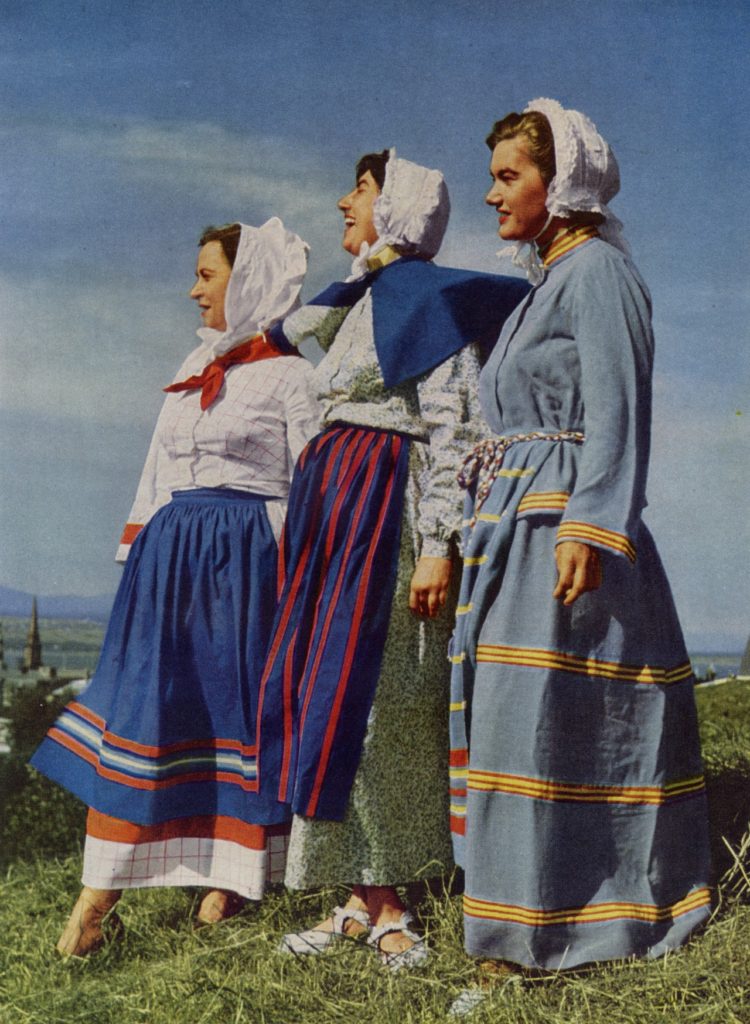
There are several photos and illustrations of traditional dress from folk dance groups in Québec who created their own designs inspired by historical and daily dress.
Outfits found in these photos and illustrations are similar to the dresses these women are wearing with the striped aprons, floral patterns, and coiffes. The wide-brimmed hat doesn’t make an appearance in this photo of the farm women, but it is found among the illustrations for folk dancing outfits.
My great-great-great-grandparents were born along the St. Lawrence River in Saint-Octave and Saint-Jean-Port-Joli. I have a great-grandfather from Trois-Pistoles who settled in the United States. My other great-grandfather from Mont-Carmel also found himself settling in the States. So seeing this photo gives me a better idea of what my great-great-great grandmothers may have worn, fashioned out of materials they had available to them but presenting a bold look nonetheless.
Why Should We Care About the Dress of the Past?
There could very well be many more traditional dress of the Québéc and Maritime provinces that are not known to most people outside of these areas. It’s unfortunate that our culture does not appear in searches for traditional dress or folk costume around the world, especially after discovering that we do have a distinct culture with its own traditional dress and folk costumes.
These outfits were created out of inspiration of historical dress by this folk dancing group. So we’ve got visuals for Nouvelle France, Ile de Orleans, Charlevoix, a “Peasant” costume, and Sunday dress.
The goal is to create visibility and become inspired through practicing the fashion arts to visually share who we are with the world. To someday be known as Franco-Americans, the culture that reclaimed themselves.
The simplicity and functionality can be seen in these various outfits throughout time. These images show an early design of what a French-Canadian woman would have worn, a bold red tuque and a French-Canadian man's outfit, the Tuque Bleu Toboggan Club in Montréal (1880), a young man in his ensemble of the Capote and ceinture fléchée, a tuque and Capote fitted for women (1880), Acadian historical dress interpretations, Acadian dancers wearing coiffes and vests with their dresses, the Acadian folk dance dress with the addition of the bright yellow star, and Acadian girls dancing and waving the flag.
The Franco-Americans of the early 20th century were already coming from a working class background, so there was no need for decorative clothing in the mills. In fact, it would have put them in even more danger with the equipment they were operating. But we can’t forget that many of them worked in the textile mills, weaving threads into fabrics. Even though working in these mills was harsh and required intense labor, it’s still a strong part of our history and culture.
For Franco-Americans, becoming Americanized throughout the generations of our families had an impact on the idea of having any cultural tradition at all.
We can step out by creating decorative visuals of who we are and express these ideas through the blooming renaissance of culture that we are shaping. There is value in cultural expression in the form of community and fashion. All are welcome to join us in artistic self-discovery and exploration because we are completely free to do so.
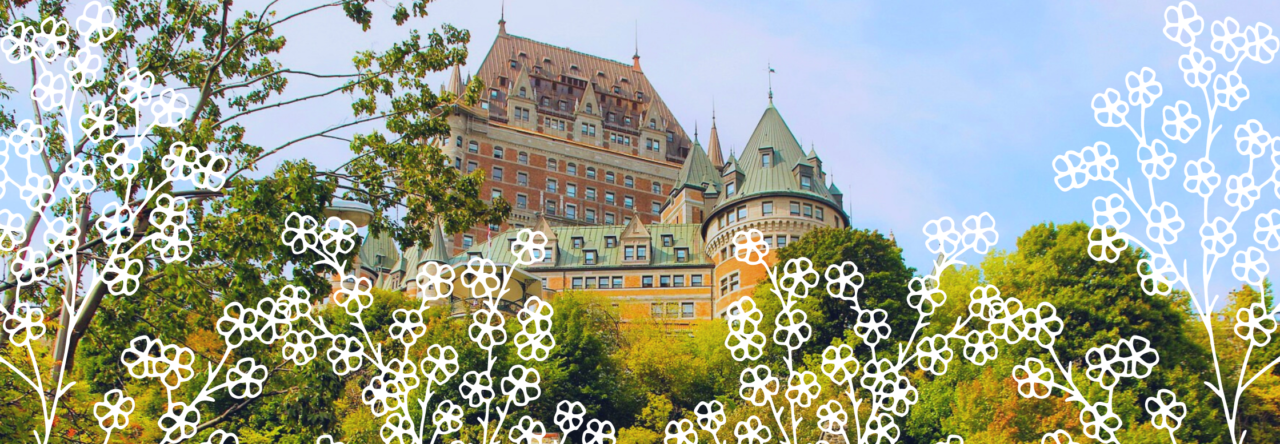














Jodi Perras
I’m not so sure about the wide-brimmed hats and long skirts, but I’d really love to own a Capote. What a great, timeless style for a coat.
Thanks for doing this research and sharing your findings.
Fayer-Marie
J’adore cet article ! Merci beaucoup pour le travail et les recherches que vous avez fait!
J’ai trop souvent regardé le tiktok avec les vêtements traditionnels ! Quel belle idée !
**Dites-moi svp ** comment puis-je trouver un simple bonnet blanc comme celui-ci ? J’aimerais le porter dans ma vie quotidienne.
Je suis né à Woonsocket, RI, et j’habite maintenant à Portland, OR —- nous avons vraiment besoin de l’influence québécoise ici.